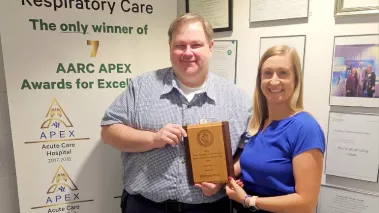Patients may consider various hospital ratings and rankings when choosing where to receive their care, but how accurate are they? Experts at Rush are national leaders in an effort to change one of the most prominent hospital ratings systems so that patients will have more reliable information.
The Centers for Medicare and Medicaid Services (the federal agency that runs the Medicare and Medicaid programs, known as CMS for short) awards hospitals nationwide an overall rating of one to five stars based on data that the agency collects from the hospitals. CMS developed the ratings, which they initiated in 2016, to help consumers make decisions about where to seek medical treatment and other kinds of care.
All three Rush hospitals — Rush University Medical Center, Rush Oak Park Hospital and Rush Copley Medical Center — received four stars in new ratings that CMS published on its Hospital Compare website on Feb. 28. The new ratings are CMS' first update since December 2017.
Four steps would help fix CMS ratings, Rush leaders say
Rush, other hospitals and hospital associations have expressed concerns about how CMS rates hospitals. Even though CMS rated the Rush hospitals highly, experts at Rush have taken a leading role nationally in identifying flaws in CMS' rating system and persuading the agency to make adjustments to it. Their goal is to help CMS develop a more accurate rating system that will enable consumers to make better-informed assessments of the quality of care hospitals provide.
Rush leaders presented their concerns in an editorial, "Four steps would help CMS fix star-rating program's unintended flaws," published on March 1 on the website of Modern Healthcare. The editorial was written by Bala Hota, MD, chief analytics officer; Omar Lateef, DO, chief medical officer; and Thomas Webb, manager of quality improvement.
The article makes recommendations for addressing the following four issues the authors say are problems with the ratings:
- The sickest of patients are more likely to be readmitted, which hurts the scores of hospitals, including Rush, that treat highly acute patients.
- The star ratings don't take into account the socioeconomic status of hospitals' patients, which can create obstacles to positive health outcomes.
- CMS adjusts readmission scores in a way that adversely affects large hospitals with high patient volumes.
- The statistical methods CMS uses causes inconsistencies in the ratings.
"Accurate analysis of data can drive better quality, better care, and even national policy," Lateef says. "Rush is determined to make sure that key national measures are transparent, measure what they are intended to measure and have no unintended consequences, especially when they are linked to reimbursement/payment."
Ratings change, excellence doesn't
The issues discussed in the editorial also help account for the change in the ratings for Rush University Medical Center and Rush Copley Medical Center, which both received five stars the last time CMS issued ratings. "The way the rating system is now, when rankings change it has more to do with changes in measurement than actual changes in quality," Hota says. "We continue to strive for excellence in quality and don’t view this move to four stars from five as reflective of a change in our care."
"No hospital rating system can be perfect, given the enormous complexities of health care today," Hota continues. "We are continuing to work with other hospitals and CMS to try to ensure that these ratings are an accurate and fair reflection of quality."
"When you consider the CMS ratings along with other evaluations, such as our No. 2 ranking among 99 leading academic medical centers by Vizient, the recognition of multiple programs as among the best in the country by U.S. News & World Report and many other honors, it's clear that Rush provides excellent clinical care every day," Lateef adds. "As always, we are very proud of the people who work at Rush and grateful for all they do to improve people's health."







